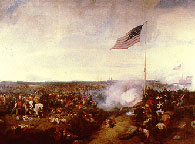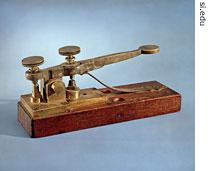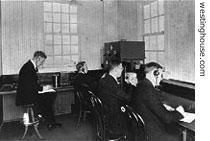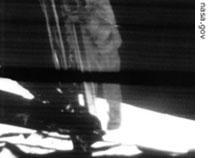VOA慢速英语-EXPLORATIONS - The Way People Communicate Has Change(在线收听)
The telegraph was the first communication device that could move information quickly from one place to another.
10 June 2008
VOICE ONE:
I’m Barbara Klein.
VOICE TWO:
And I’m Steve Ember with EXPLORATIONS in VOA Special English. Today, we begin a series of three programs about the Information Age. Our first program tells about the history of communications.
(MUSIC)
VOICE ONE:
Communicating information always has been extremely important. Throughout history, some information has had value beyond measure. The lack of information often costs huge amounts of money and, sometimes, many lives.
 |
| ''The Battle of New Orleans'' by Eugene Louis Lami, 1839 |
One example of this took place near New Orleans, Louisiana. Britain and the United States were fighting the War of Eighteen Twelve. The Battle of New Orleans is a famous battle. As in all large battles, hundreds of troops were killed or wounded.
After the battle, the Americans and the British learned there had been no need to fight. Negotiators for the United States and Britain had signed a peace treaty in the city of Ghent, Belgium, two weeks earlier. Yet news of the treaty had not reached the United States before the opposing troops met in New Orleans. The battle had been a terrible waste. People died because information about the peace treaty traveled so slowly.
VOICE TWO:
From the beginning of human history, information traveled only as fast as a ship could sail. Or a horse could run. Or a person could walk.
People experimented with other ways to send messages. Some people tried using birds to carry messages. Then they discovered it was not always a safe way to send or receive information.
A faster method finally arrived with the invention of the telegraph. The first useful telegraphs were developed in Britain and the United States in the eighteen thirties.
 |
| An early telegraph key |
The telegraph was the first instrument used to send information using wires and electricity. The telegraph sent messages between two places that were connected by telegraph wires. The person at one end would send the information. The second person would receive it.
Each letter of the alphabet and each number had to be sent separately by a device called a telegraph key. The second person would write each letter on a piece of paper as it was received. Here is what it sounds like. For our example we will only send you three letters: VOA. We will send it two times. Listen closely.
(SOUND)
VOICE ONE:
In the eighteen fifties, an expert with a telegraph key could send about thirty-five to forty words in a minute. It took several hours to send a lot of information. Still, the telegraph permitted people who lived in cities to communicate much faster. Telegraph lines linked large city centers. The telegraph soon had a major influence on daily life.
The telegraph provided information about everything. Governments, businesses and individuals used the telegraph to send information. At the same time, newspapers used the telegraph to get information needed to tell readers what was happening in the world. Newspapers often were printed four or five times a day as new information about important stories was received over the telegraph. The telegraph was the quickest method of sending news from one place to another.
VOICE TWO:
On August fifth, eighteen fifty-eight, the first message was transmitted by a wire cable under the Atlantic Ocean. The wire linked the United States and Europe by telegraph. This meant that a terrible mistake like the battle of New Orleans would not happen again.
Reports of daily news events in Europe began to appear in American newspapers. And news of the United States appeared in European newspapers. Information now took only a matter of hours to reach most large cities in the world. This was true for the big cities linked by the telegraph. However, it was different if you lived in a small farming town, kilometers away from a large city. The news you got might be a day or two late. It took that long for you to receive your newspaper.
(SOUND: KDKA first broadcast)
VOICE ONE:
 |
| Pittsburgh's KDKA, the first commercially licensed radio station |
On November second, nineteen twenty, radio station KDKA in Pittsburgh, Pennsylvania broadcast the first radio program. That broadcast gave the results of a presidential election.
Within a few short years, news and information could be heard anywhere a radio broadcast could reach. Radios did not cost much. So most people owned at least one radio. Radio reporters began to speak to the public from cities where important events were taking place.
Political leaders also discovered that radio was a valuable political tool. It permitted them to talk directly to the public. If you had a radio, you did not have to wait until your newspaper arrived. You could often hear important events as they happened.
VOICE TWO:
Some people learned quickly that information meant power. In the nineteen thirties, many countries began controlling information. The government of Nazi Germany is a good example.
Before and during World War Two, the government of Nazi Germany controlled all information the German people received. The government controlled all radio broadcasts and newspapers. The people of Germany only heard or read what the government wanted them to hear or read. It was illegal for them to listen to a foreign broadcast.
VOICE ONE:
After World War Two, a new invention appeared -- television. In industrial nations, television quickly became common in most homes. Large companies were formed to produce television programs. These companies were called networks. Networks include many television stations linked together that could broadcast the same program at the same time.
Most programs were designed to entertain people. There were movies, music programs and game programs. However, television also broadcast news and important information about world events. It broadcast some education programs, too. The number of radio and television stations around the world increased. It became harder for a dictator to control information.
(MUSIC)
VOICE TWO:
In the nineteen fifties, two important events took place that greatly affected the communication of information. The first was a television broadcast that showed the East Coast and the West Coast of the United States at the same time. A cable that carried the pictures linked the two coasts. So people watching the program saw the Pacific Ocean on the left side of the screen. They saw the Atlantic Ocean on the right side of the screen.
It was not a film. People could see two reporters talk to each other even though a continent separated them. Modern technology made this possible.
VOICE ONE:
The other event happened on September twenty-fifth, nineteen fifty-six. That was when the first telephone cable under the Atlantic Ocean made it possible to make direct telephone calls from the United States to Europe. Less than six years later, in July, nineteen sixty-two, the first communications satellite was placed in orbit around the Earth. The speed of information greatly increased again.
VOICE TWO:
By the year nineteen hundred, big city newspapers could provide people with information that was only hours old. Now, both radio and television, with the aid of satellite communications, could provide information immediately. People who lived in a small village could listen to or watch world events as they happened.
 |
| Neil Armstrong stepping onto the surface of the moon |
A good example is when American astronaut Neil Armstrong became the first person to walk on the moon. Millions of people around the world watched as he carefully stepped onto the moon on July twentieth, nineteen sixty-nine.
People in large cities, small towns and villages saw the event as it was happening. There was no delay in communicating this important information.
VOICE ONE:
A few years after Neil Armstrong stepped on the moon, the United States Department of Defense began an experiment. That experiment led to a system that could send huge amounts of information around the world in seconds. Experts called it the beginning of the Information Age. The story of that experiment will be our report next week on EXPLORATIONS.
(MUSIC)
VOICE TWO:
This program was written by Paul Thompson. It was produced by Mario Ritter. I’m Steve Ember.
VOICE ONE:
And I’m Barbara Klein. You can read scripts and download audio on our Web site, voaspecialenglish.com. Join us again next week for EXPLORATIONS in VOA Special English.